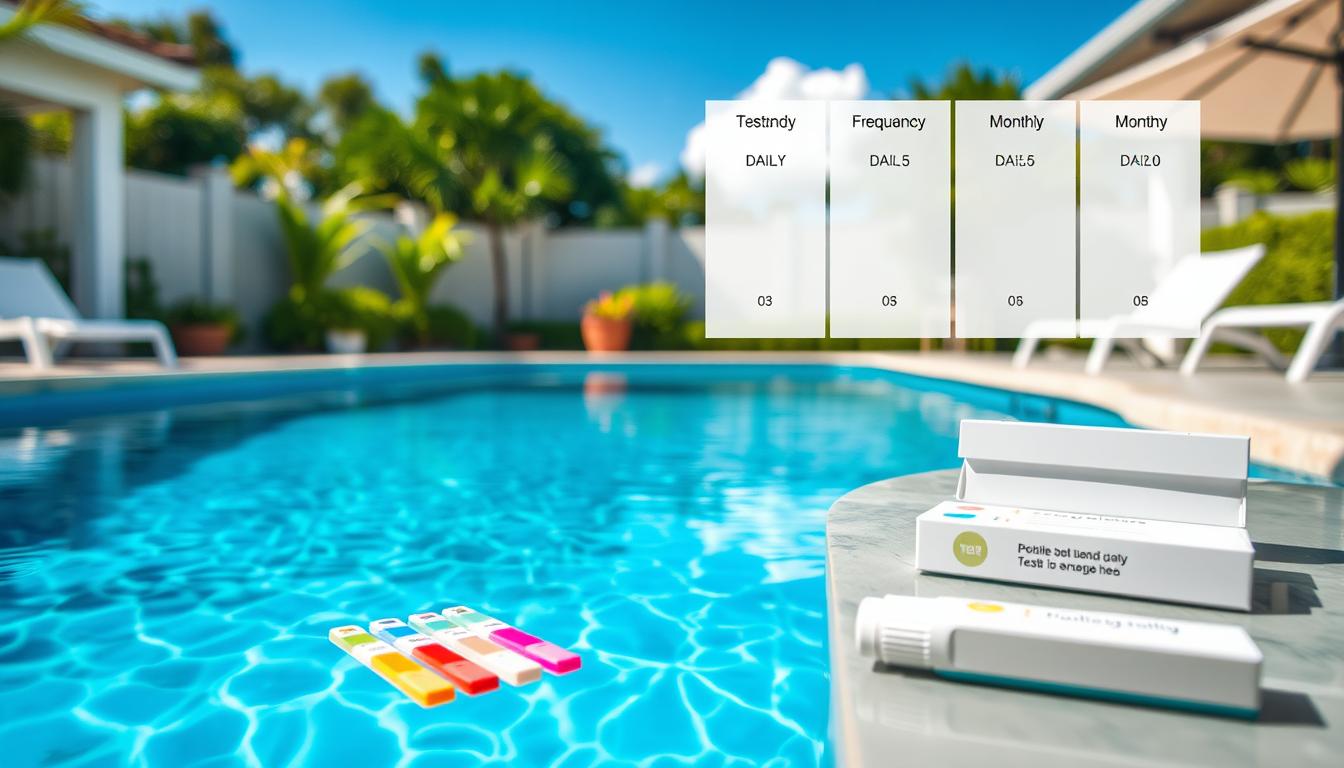
Is your pool water safe for swimming? Regular testing ensures a clean, healthy environment. Discover how often you should test your pool water.
Balanced chemicals prevent algae growth and keep swimmers safe. A proper pool maintenance schedule and swimming pool testing kit help maintain your pool’s condition.
We’ll explore recommended testing frequencies for various pool parameters. This includes daily checks for chlorine levels and pH balance monitoring. We’ll also cover weekly and monthly assessments.
Special circumstances may require more frequent testing. These include heavy pool use or rainfall. Learn what to look for in each pool chemistry analysis.
This guide will help you maintain safe swimming conditions. You’ll be able to keep your pool sparkling clean all season long.
Key Takeaways
- Test pool water at least once a week for optimal pH balance, alkalinity, and sanitizer levels.
- Perform daily checks of chlorine levels (1-3 ppm) and pH (7.2-7.6).
- Conduct weekly tests for total alkalinity (80-120 ppm), calcium hardness (200-400 ppm), and cyanuric acid (30-50 ppm if using stabilized chlorine).
- Assess total dissolved solids and phosphate levels monthly to maintain water quality and prevent algae growth.
- Increase testing frequency after heavy pool use, rainfall, or when adding chemicals for proper pool maintenance.
Why Regular Pool Water Testing is Crucial
Regular pool water testing keeps your swimming environment safe and enjoyable. It helps maintain balanced chemistry and prevents algae and bacteria growth. Proper testing also extends the life of your pool equipment.
By monitoring chemical levels, you ensure a comfortable experience for swimmers. This practice minimizes scale buildup and corrosion, saving you money on repairs.
Maintaining Balanced Chemical Levels
Proper pool chemistry is vital for several reasons. The ideal pH range of 7.4 to 7.6 prevents eye and skin irritation.
Maintaining the right levels of chlorine, alkalinity, and calcium hardness keeps your pool clean. It also ensures the water remains clear and free of harmful contaminants.
Preventing Algae Growth and Bacteria
Imbalanced water chemistry can lead to algae and bacteria growth. This makes your pool unsightly and potentially unsafe for swimmers.
Regular testing helps you spot and fix imbalances quickly. Proper chlorine levels and balanced pH create an environment that discourages unwanted organisms.
Ensuring Swimmer Safety and Comfort
Testing pool water regularly keeps it comfortable for swimmers. It prevents eye and skin irritation, allowing everyone to enjoy the pool.
Identifying issues with foreign chemicals like copper or iron is crucial. This prevents staining of pool surfaces and potential health concerns.
Prolonging Pool Equipment Lifespan
Neglecting water testing can lead to scale buildup and corrosion. This can significantly reduce the lifespan of your pool equipment.
Balanced chemical levels protect pumps, filters, and heating systems. This approach saves money on repairs and ensures efficient operation of your pool equipment.
| Chemical | Ideal Range |
|---|---|
| Chlorine | 1.0–4.0 ppm |
| pH | 7.4-7.6 |
| Total Alkalinity | 80–120 ppm |
| Calcium Hardness | 200–400 ppm |
| Cyanuric Acid | 30–50 ppm |
How Often to Test Pool Water for Optimal Maintenance
Regular pool water testing keeps your swimming pool safe and healthy. Testing frequency depends on pool use, weather, and specific parameters. Daily, weekly, and monthly checks help maintain water quality and prevent issues.
An optimal testing schedule includes daily chlorine and pH checks. Weekly tests cover alkalinity and hardness. Monthly monitoring involves TDS and phosphate levels.
Daily Testing: Chlorine and pH Levels
Chlorine and pH are crucial for pool water safety and comfort. Free chlorine should stay between 1-3 ppm. pH levels should range from 7.2 to 7.6.
Daily testing allows quick adjustments to maintain proper water balance. This ensures effective sanitization and swimmer comfort.
Weekly Testing: Total Alkalinity, Calcium Hardness, and Cyanuric Acid
Weekly checks cover total alkalinity, calcium hardness, and cyanuric acid. Total alkalinity should be 80-120 ppm to stabilize pH levels.
Calcium hardness levels should be 200-400 ppm to prevent scaling and corrosion. Cyanuric acid, a chlorine stabilizer, should be 30-50 ppm.
| Parameter | Ideal Range | Testing Frequency |
|---|---|---|
| Free Chlorine | 1-3 ppm | Daily |
| pH | 7.2-7.6 | Daily |
| Total Alkalinity | 80-120 ppm | Weekly |
| Calcium Hardness | 200-400 ppm | Weekly |
| Cyanuric Acid | 30-50 ppm | Weekly |
Monthly Testing: Total Dissolved Solids and Phosphates
Monthly tests focus on Total Dissolved Solids (TDS) and phosphate levels. High TDS can affect water clarity and chemical effectiveness.
Replace water if TDS exceeds 1,500 ppm. Keep phosphates below 100 ppb to reduce algae growth risk.
Follow this testing schedule for a safe, comfortable pool. Test more often after heavy use, rain, or storms. This ensures chemical levels stay within desired ranges.
Special Circumstances for Pool Water Testing
Regular pool water testing is crucial for a safe swimming environment. Some situations require extra attention and thorough testing. Opening and closing the pool season demands a complete analysis of all chemical levels.
This includes chlorine (2.0-4.0 ppm), pH (7.4-7.6), total alkalinity (80-120 ppm), and calcium hardness (200-400 ppm). Cyanuric acid levels (40-100 ppm) should also be checked. Proper balance at season’s start and end prevents future issues.
For ongoing water quality problems, consider professional pool services. Experts can provide detailed analysis and valuable insights for optimal water chemistry. They can identify and solve underlying issues, keeping your pool in top shape.
After heavy pool use, like parties or long swim sessions, test chlorine and pH levels quickly. These events can deplete free chlorine and change pH balance. This makes the water prone to bacteria and algae growth.
You may need to shock the pool to restore proper balance and clarity. Test the water more often until levels stabilize. Stay alert to these special circumstances with proper testing and treatment.
This ensures your pool remains a safe, enjoyable oasis all season long. Regular, comprehensive water testing is key to worry-free swimming experiences.







